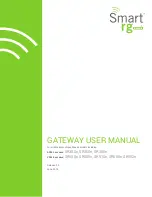
MTX
‐
3G
‐
JAVA
Family
www.mtx
‐
terminals.com
www.mtxm2m.com
2015/10
v1.6
Page
86
/
109
MTX
M2M®
by
MATRIX
ELECTRONICA
S.L.U
9.2
How to install the modem
9.2.1
Power
supply
Use
a
high
‐
quality
power
supply
cable
with
low
resistance.
This
ensures
that
the
voltages
at
the
connector
pins
are
within
the
allowed
range,
even
during
the
maximum
peak
current.
When
the
unit
is
powered
from
a
battery
or
a
high
current
supply,
connect
a
fast
1.25A
fuse
in
line
with
the
positive
supply.
This
protects
the
power
cabling
and
modem.
9.2.2
Securing
the
modem
Before
securing
the
modem
take
into
account
the
amount
of
additional
space
required
for
the
mating
connectors
and
cables
that
will
be
used
in
the
application.
•
Where
access
is
restricted,
it
may
be
easier
to
connect
all
the
cables
to
the
modem
prior
to
securing
it
in
the
application.
•
Securely
attach
the
MTX
‐
3G
‐
JAVA
Terminal
modem
to
the
host
application
using
two
3mm
diameter
pan
‐
head
screws
9.3
Antenna
9.3.1
General
The
antenna
is
the
component
in
your
system
that
maintains
the
radio
link
between
the
network
and
the
modem.
Since
the
antenna
transmits
and
receives
electromagnetic
energy,
its
efficient
function
will
depend
on:
•
The
type
of
antenna
(for
example,
circular
or
directional);
•
The
placement
of
the
antenna;
•
Communication
disturbances
in
the
vicinity
in
which
the
antenna
operates.
In
the
sections
below,
issues
concerning
antenna
type,
antenna
placement,
antenna
cable,
and
possible
communication
disturbances
are
addressed.
In
any
event,
you
should
contact
your
local
antenna
manufacturer
for
additional
information
concerning
antenna
type,
cables,
connectors,
antenna
placement,
and
the
surrounding
area.
You
should
also
determine
whether
the
antenna
needs
to
be
grounded
or
not.
Your
local
antenna
manufacturer
might
be
able
to
design
a
special
antenna
suitable
for
your
application.
9.3.2
Antenna
type
Make
sure
that
you
choose
the
right
type
of
antenna
for
the
modem.
Consider
the
following
requirements:
•
The
antenna
must
be
designed
for
one
of
the
frequency
bands
in
use;
please
ask
your
network
provider
for
more
information:
o
UMTS
800/850/900/1900/2100
MHz
o
GSM
850/900/1800/1900
MHz
•
The
impedance
of
the
antenna
and
antenna
cable
must
be
50
Ω
;
•
The
antenna
output
‐
power
handling
must
be
a
minimum
of
2W
















































